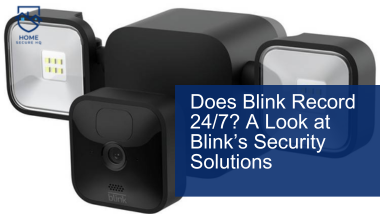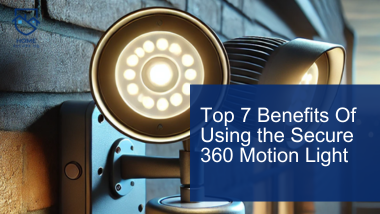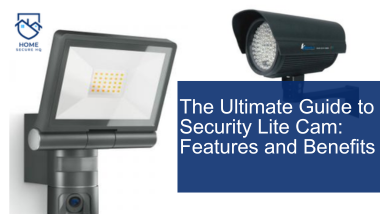Does Blink record 24/7, or are you leaving gaps in your security when it matters most? With the demand for constant surveillance, knowing your home security system has blind spots could make all the difference.
However, one of the most frequently asked questions from potential buyers is, “Does Blink record 24/7?” Should you rethink relying solely on motion-activated recording, or is Blink’s smart approach enough to keep your home truly safe?
This post will explore if Blink cameras offer continuous recording, what their limitations are to other security systems.
Does Blink Record 24/7?
The simple answer to the question, “Does Blink record 24/7?”, is no. Blink cameras do not provide continuous recording. Instead, they rely on motion detection to trigger recording events.
There are several reasons for this limitation:
- Battery Life Considerations:
Blink cameras are designed with long-lasting batteries, often touted to last up to two years on AA batteries. Continuous recording would drain the battery much faster, defeating one of their key selling points.
By sticking to motion-triggered events, Blink can offer a wireless, battery-powered solution that doesn’t require frequent charging or changing of batteries.
- Storage Efficiency:
Constant recording generates an enormous amount of data. Even with cloud storage, recording 24/7 would require significant amounts of bandwidth and space.
Blink’s design focuses on capturing moments of interest, rather than recording non-stop, thus preserving storage space for more relevant footage.
Can Blink Cameras Be Set Up for Continuous Monitoring?
While Blink cameras do not offer 24/7 recording, they do provide an alternative: Live View. The Live View feature allows users to access a real-time video feed from their camera at any given time. This can be particularly useful for checking in on your property when you’re away.
However, it’s important to note that Live View doesn’t record continuously either. It simply offers real-time monitoring for up to five minutes at a time, after which it must be manually refreshed to continue.
Additionally, unless motion is detected during the live view session, no footage is stored for future reference. This live feed serves more as a spot-check feature rather than a comprehensive continuous recording solution.
Blink’s Core Features
Blink cameras are designed to provide home security solutions without the high costs typically associated with more advanced systems. The range includes Blink Indoor, Blink Outdoor, and the compact Blink Mini.
These cameras have grown in popularity due to their ease of setup, wireless options, and long battery life.
One of the defining features of Blink cameras is their motion-activated recording. This means that instead of continuously capturing footage, Blink cameras begin recording when they detect motion within their range.
This approach helps conserve battery life and minimizes the amount of storage needed to save recordings.
Blink cameras offer two primary options for saving recordings: cloud-based storage and local storage via a USB flash drive plugged into the Blink Sync Module 2.
While cloud storage provides more flexibility, local storage ensures that users can keep footage without monthly fees.
Enhancing Security with Blink’s Smart Solutions
Even without 24/7 recording, Blink offers a range of features to enhance home security through smart technology.
The cameras can integrate with Amazon Alexa, allowing users to control the system via voice commands or set up routines to enhance protection. For example, you can program your Alexa devices to automatically turn on the live feed or alert you if Blink detects motion.
Furthermore, Blink’s motion detection can be optimized to fit specific security needs. Placement is key in making sure that the camera effectively captures any relevant movement while minimizing false alarms.
For example, placing cameras near entryways or other high-traffic areas increases the chances that they will detect any suspicious activity.
By setting the sensitivity of motion detection, users can adjust the frequency of recording events, helping them avoid unnecessary recordings of trivial movements like passing cars or pets. This keeps the camera focused on what truly matters.
Blink’s Subscription Plans and How They Impact Recording
While Blink’s core features are available without any subscription, signing up for one of Blink’s subscription plans does offer additional benefits in terms of video history and cloud storage.
For instance, Blink’s Basic Plan allows a single camera to save clips for up to 60 days in the cloud, while the Plus Plan covers unlimited cameras at a single location.
It’s important to understand, though, that even with these plans, Blink cameras still do not support 24/7 recording. The plans only extend the amount of time videos are stored in the cloud, giving users more access to past recordings triggered by motion detection.
Comparing Blink to Other 24/7 Recording Systems
For homeowners specifically looking for 24/7 recording, Blink may not be the best option. Systems like Nest or Arlo provide continuous recording but usually require wired power sources to avoid draining the battery. They also tend to be more expensive and involve higher costs in terms of cloud storage and subscription plans.
For instance, Nest cameras offer Nest Aware subscriptions, which allow for 24/7 recording, but the pricing is significantly higher than Blink’s free or basic plan. Moreover, these systems often require a hardwired power connection, which adds to installation complexity and cost
So, why doesn’t Blink offer 24/7 recording? Blink’s design is primarily focused on cost-effectiveness and battery efficiency.
By avoiding continuous recording, Blink ensures that its wireless cameras can function for extended periods without needing frequent maintenance. This approach keeps the overall price low and eliminates the need for constant charging or wiring.
Is Blink Right for You?
For many homeowners, Blink’s approach to motion-based recording offers a perfect balance between affordability, functionality, and ease of use. Its wireless setup and extended battery life make it ideal for those who want a reliable security camera without the hassle of constant maintenance. However, if 24/7 recording is a must for your home security needs, you might want to consider other systems like Nest or Arlo, which cater more specifically to continuous monitoring.
If you’re looking for a smart, budget-friendly system that prioritizes battery life and simplicity, Blink’s motion-activated cameras could be the perfect fit for you.
Conclusion
Blink cameras do not offer 24/7 recording but are designed to provide motion-activated, smart home security that is easy to install and maintain. By focusing on motion detection, Blink balances cost-effectiveness with essential home security features.
With added functionality such as Live View and Alexa integration, Blink is an excellent option for homeowners seeking a reliable, long-lasting security system. For those requiring continuous surveillance, though, alternatives like Nest or Arlo may be more suitable.







